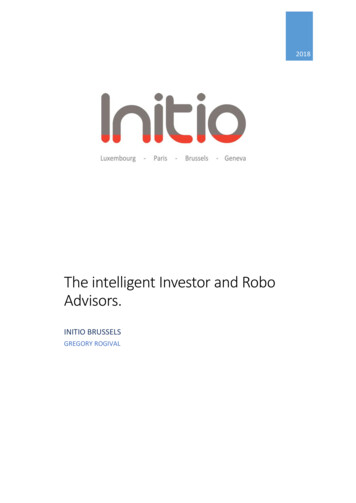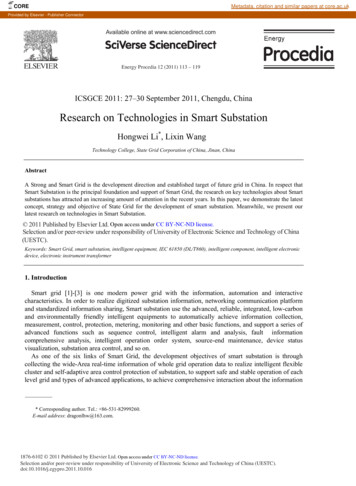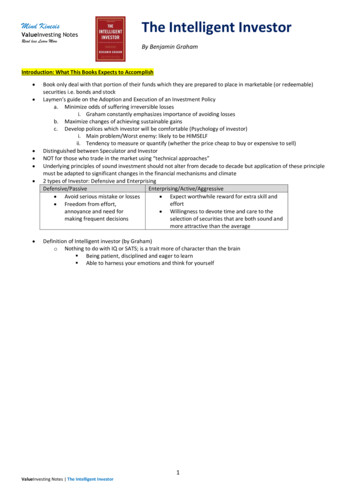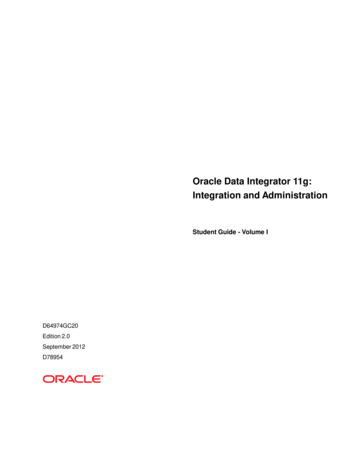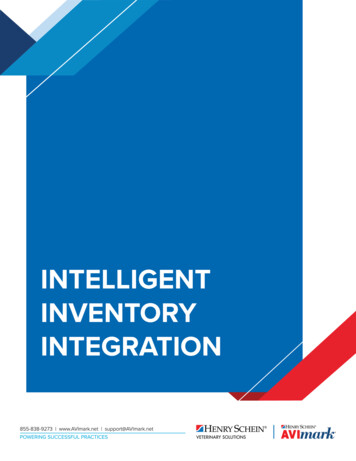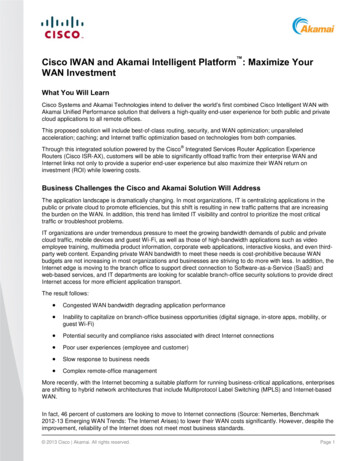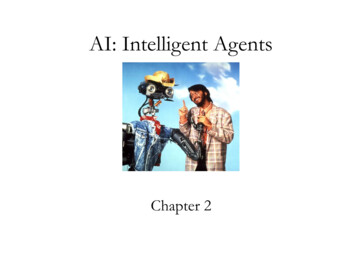
Transcription
AI: Intelligent AgentsChapter 2
Outline Agents and environments Rationality PEAS (Performance measure, Environment, Actuators, Sensors) Environment types Agent types
Agents An “agent” is anything that can be viewed as perceiving its environment throughsensors and acting upon that environment through actuators. Percept refers to the agent’s perceptual inputs at a given time instant; an agent’sperceptual sequence is the complete history of everything the agent has everperceived. In general, an agent’s choice of action at any given instant can depend on the entireprecept sequence observed to date, but not on anything it hasn’t perceived.
Agents and environmentsAgents include humans, robots, softbots, thermostats, etc.The agent function maps from percept histories to actions:f : P AThe agent program runs on the physical architecture to produce f.
Vacuum-cleaner world Percepts: location and contents, e.g., [A,Dirty] Actions: Left, Right, Suck, NoOpA vacuum-cleaner agentPercept an], [A,Clean][A,Clean], [A,Dirty].What is the right function?Can it be implemented in a small agent program?ActionRightSuckLeftSuckRightSuck.
Good Behavior: Rationality A rational agent is one that “does the right thing”, i.e. the table for the agent functionis filled out “correctly.” But what does it mean to do the right thing? We use a performance measure toevaluate any given sequence of environment states. Importantly, we emphasize that the performance is assessed in terms of environmentstates and not agent states; self-assessment is often susceptible to self-delusion. Here is a relevant rule of thumb: It is advisable to design performance measures according towhat one actually wants in the environment, as opposed to how one believes that agent should behave.
RationalityWhat is rational at any given time depends on (at least) four things:(1) The performance measure(2) The agent’s prior knowledge(3) The actions the agents can perform(4) The agent’s percept sequence to date.Definition of a rational agent: For each possible precept sequence, a rational agent should selectan action that is expected to maximize its performance measure, given the evidence provided by thepercept sequence and whatever built-in knowledge the agent possesses.
Rationality Note that rationality is not the same as omniscience; an omniscient agenknows theactual outcome of its actions and can act accordingly. Percepts may not supply allrelevant information. Similarly, rationality is not the same thing as clairvoyance (action outcomes may beunexpected) nor perfection (we maximize expected performance, not actualperformance). Performing actions in order to modify future percepts (i.e. information gathering) is acrucial part of rationality and is closely aligned with exploration.
An intelligent agent should not only gather information, but also learn. The agent’s initial configuration could reflect some prior knowledge of theenvironment, but as the agent gains experience, this may be modified andaugmented (an extreme case is when the environment is known a priori). Generally speaking, a rational agent should be autonomous, in the sense that it learnswhat it can to compensate for partial or incorrect prior knowledge. After sufficientexperience of its environment, the behavior of a rational agent can becomeeffectively independent of its prior knowledge. Ideally, the incorporation of learning allows for the design of a single rational agentthat will succeed in a variety of different environments and for a variety of tasks (thegoal of AGI).
PEASTo design a rational agent, we must specify the task environment.Consider, e.g., the task of designing an automated taxi:Performance measure?Environment?Actuators?Sensors?
PEASTo design a rational agent, we must specify the task environmentConsider, e.g., the task of designing an automated taxi:Performance measure safety, destination, profits, legality, comfort, .Environment US streets/freeways, traffic, pedestrians, weather, .Actuators steering, accelerator, brake, horn, speaker/display, .Sensors video, accelerometers, gauges, engine sensors, keyboard, GPS, .
PEASAgent: Medical diagnosis systemPerformance measure: Healthy patient, minimize costs,lawsuitsEnvironment: Patient, hospital, staffActuators: Screen display (questions, tests, diagnoses,treatments, referrals)Sensors: Keyboard (entry of symptoms, findings, patient'sanswers)
PEAS Agent: Part-picking robot Performance measure: Percentage of parts in correctbins Environment: Conveyor belt with parts, bins Actuators: Jointed arm and hand Sensors: Camera, joint angle sensors
PEAS Agent: Interactive English tutor Performance measure: Maximize student'sscore on test Environment: Set of students Actuators: Screen display (exercises,suggestions, corrections) Sensors: Keyboard
Environment types Fully observable (vs. partially observable): An agent's sensorsgive it access to the complete state of the environment at eachpoint in time. Deterministic (vs. stochastic): The next state of the environmentis completely determined by the current state and the actionexecuted by the agent. (If the environment is deterministicexcept for the actions of other agents, then the environment isstrategic). Episodic (vs. sequential): The agent's experience is divided intoatomic "episodes" (each episode consists of the agent perceivingand then performing a single action), and the choice of action ineach episode depends only on the episode itself.
Environment types Static (vs. dynamic): The environment is unchangedwhile an agent is deliberating. (The environment issemidynamic if the environment itself does not changewith the passage of time but the agent's performancescore does) Discrete (vs. continuous): A limited number of distinct,clearly defined percepts and actions. Single agent (vs. multiagent): An agent operating byitself in an environment.
Environment typesFully e agentChess witha clockYesStrategicNoSemiYesNoChess withouta clockYesStrategicNoYesYesNoTaxi drivingNoNoNoNoNoNo The environment type largely determines the agent design The real world is (of course) partially observable, stochastic, sequential,dynamic, continuous, multi-agent
Solitaire BackgammonInternet YesSingle-agent?YesNoYes (except auctions)The environment type largely determines the agent designTaxiNoNoNoNoNoNo
Agent typesFour basic types in order of increasing generality:– simple reflex agents– reflex agents with state– goal-based agents– utility-based agentsAll these can be turned into learning agents
Simple Reflex Agents The simplest kind of agent. These agents select actions on the basis of the current percept,ignoring the rest of the percept history. (An example for the vacuum world is below).function Reflex-Vacuum-Agent([location,status]) returns an actionif status Dirty then return Suckelse if location A then return Rightelse if location B then return Left Notice that the vacuum agent program is very small compared to a look-up table; the chiefreduction comes from ignoring the percept history (reduction in rule set from 4 T to just 4). Simple reflex agents are, naturally, simple, but they turn out to be of limited intelligence. The agentwill only work if the correct decision can be made on the basis of only the current percept (so only ifthe environment is fully observable).
Function MODEL-BASED-REFLEX-AGENT (percept) returns an actionPersistent: state, the agent’s current conception of the world statemodel, a description of how the next state depends on the current state and actionrules, a set of condition-action rulesaction, the most recent action, initially nonestate - UPDATE-STATE (state, action percept, model)rule - RULE-MATCH(state, rules)action - rule.ACTIONreturn action
Goal-based Reflex Agents Often, to make the correct decision, the agent needs some sort of goal informationthat describes situations that are desirable. Occasionally, goal-based action selection is straightforward (e.g. follow the action thatleads directly to the goal); at other times, however, the agent must consider also searchand planning. Decision making of this latter kind involves consideration of the future. Goal-based agents are commonly more flexible than reflex agents.
Utility-based Reflex Agents Goals alone are not enough to generate high-quality behavior in most environments. An agent’s utility function is essentially an international of the performance measure.If the internal utility function and the external performance measure are in agreement,then an agent that chooses actions to maximize its utility will be rational according tothe external performance measure. A utility-based agent has many advantages in terms of flexibility and learning (e.g. inthe case of conflicting goals and cases when there exist several goals).
Learning Agents A learning agent is comprised of (4) components: (1) the learning element, which isresponsible for making improvements; (2) the performance element, which isresponsible for selecting external actions; (3) the critic, which gives feedback to theagent, and determines how the performance should be modified; (4) the problemgenerator is responsible for suggesting actions that will lead to new and informativeexperiences.Consider the taxi example:Performance element: whatever collection of knowledge and procedures the taxi hasfor selecting its driving actions.Learning element: Formulates a rule based on experienceCritic: Adds new rules, based on feedback. Problem Generator: Identify certain areasof behavior in need of improvement and suggest experiments.
SummaryAgents interact with environments through actuators and sensorsThe agent function describes what the agent does in all circumstancesThe performance measure evaluates the environment sequenceA perfectly rational agent maximizes expected performanceAgent programs implement (some) agent functionsPEAS descriptions define task environmentsEnvironments are categorized along several dimensions:observable? deterministic? episodic? static? discrete? single-agent?Several basic agent architectures exist:reflex, reflex with state, goal-based, utility-based
AI: Intelligent Agents Chapter 2. Outline Agents and environments Rationality PEAS (Performance measure, Environment, Actuators, Sensors) Environment types Agent types . Agents i An agent µ is anything
